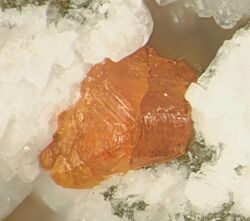Chemistry:Manganokhomyakovite
| Manganokhomyakovite | |
|---|---|
 Manganokhomyakovite | |
| General | |
| Category | Cyclosilicates |
| Formula (repeating unit) | Na 12Sr 3Ca 6Mn 3Zr 3W(Si 25O 73)(O,OH,H 2O) 3(OH,Cl) 2 (original form) |
| Strunz classification | 9.CO.10 (10 ed) 8/E.23-35 (8 ed) |
| Dana classification | 64.1.2.6 |
| Crystal system | Trigonal |
| Crystal class | Ditrigonal pyramidal (3m) (same H-M symbol) |
| Space group | R3m |
| Unit cell | a = 14.28, c = 30.12 [Å] (approximated); Z = 3 |
| Identification | |
| Color | Orange to orange-red |
| Crystal habit | Pseudo-octahedra |
| Cleavage | None |
| Fracture | Uneven |
| Tenacity | Brittle |
| Mohs scale hardness | 5–6 |
| |re|er}} | Vitreous |
| Streak | White |
| Diaphaneity | Transparent to translucent |
| Density | 3.13 (measured), 3.17 (calculated) |
| Optical properties | Uniaxial (−) |
| Refractive index | nω = 1.63, nε = 1.63 (approximated) |
| Pleochroism | None |
| References | [1][2] |
Manganokhomyakovite is a very rare mineral of the eudialyte group,[1] with the chemical formula Na
12Sr
3Ca
6Mn
3Zr
3WSi(Si
9O
27)
2(Si
3O
9)
2O(O,OH,H
2O)
3(OH,Cl)
2.[2] This formula is in extended form (based on the original one), to show the presence of cyclic silicate groups and domination of silicon at the M4 site, basing on the nomenclature of the eudialyte group.[4] Some niobium substitutes for tungsten in khomyakovite. As suggested by its name, manganokhomyakovite is a manganese-analogue of khomyakovite, the latter being more rare.[2] The two minerals are the only group representatives, beside taseqite, with species-defining strontium, although many other members display strontium diadochy. Manganokhomyakovite is the third eudialyte-group mineral with essential tungsten (after johnsenite-(Ce) and khomyakovite).[1]
Occurrence and association
Manganokhomyakovite, khomyakovite, johnsenite-(Ce) and oneillite are four eudialyte-group minerals discovered in alkaline rocks of Mont Saint-Hilaire, Quebec, Canada.[5] Association of manganokhomyakovite is rich and includes: aegirine, albite, analcime, annite, kupletskite, microcline, natrolite, sodalite, titanite, wöhlerite, zircon, cerussite, galena, molybdenite, pyrite, pyrrhotite, and sphalerite.[2]
Notes on chemistry
Impurities in manganokhomyakovite include niobium and iron, with traces of rare earth elements, hafnium, titanium, tantalum, and aluminium.[2]
References
- ↑ 1.0 1.1 1.2 Mindat, Manganokhomyakovite, http://www.mindat.org/min-7137.html
- ↑ 2.0 2.1 2.2 2.3 2.4 Johnsen, O., Gault., R.A., Grice, J.D., and Ercit, T.S., 1999: Khomyakovite and manganokhomyakovite, two new members of the eudialyte group from Mont Saint-Hilaire, Quebec, Canada. The Canadian Mineralogist 37, 893–899
- ↑ Warr, L.N. (2021). "IMA–CNMNC approved mineral symbols". Mineralogical Magazine 85 (3): 291–320. doi:10.1180/mgm.2021.43. Bibcode: 2021MinM...85..291W.
- ↑ Johnsen, O., Ferraris, G., Gault, R.A., Grice, D.G., Kampf, A.R., and Pekov, I.V., 2003. The nomenclature of eudialyte-group minerals. The Canadian Mineralogist 41, 785–794
- ↑ "Poudrette quarry (Demix quarry; Uni-Mix quarry; Desourdy quarry; Carrière Mont Saint-Hilaire), Mont Saint-Hilaire, La Vallée-du-Richelieu RCM, Montérégie, Québec, Canada - Mindat.org". http://www.mindat.org/loc-599.html. Retrieved 2016-03-11.
 |

